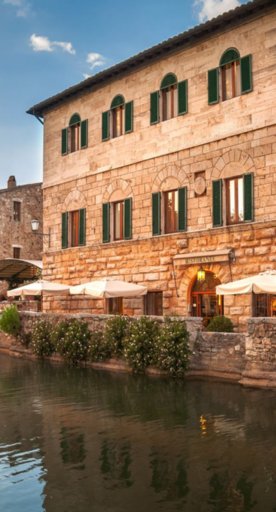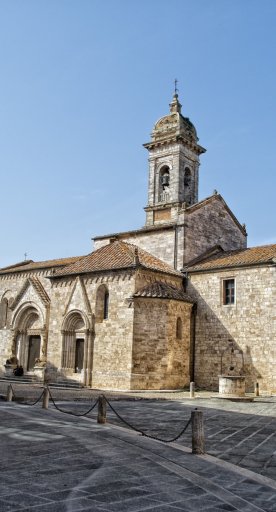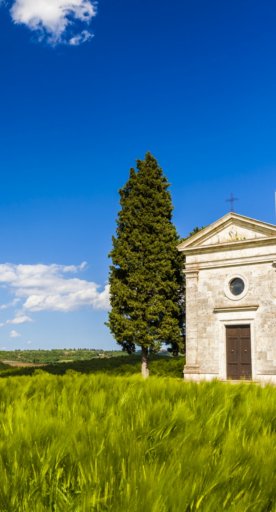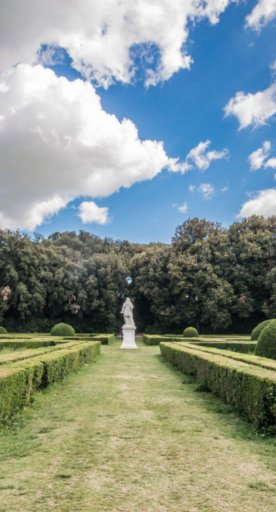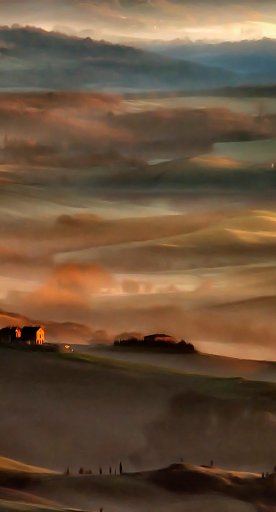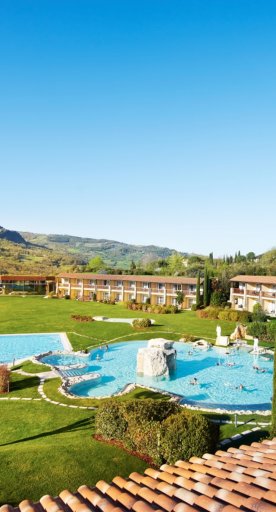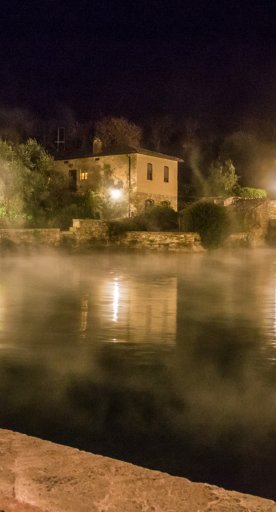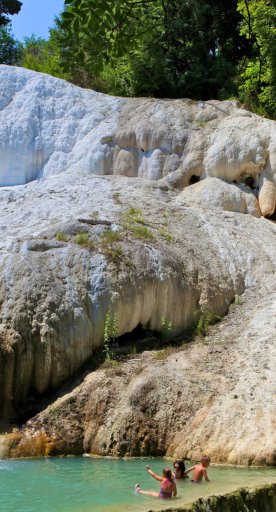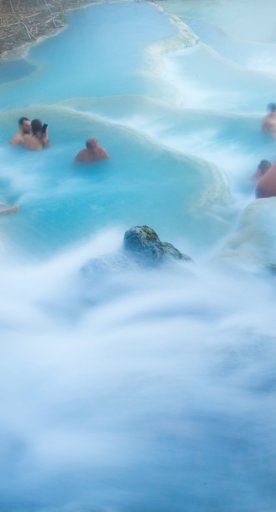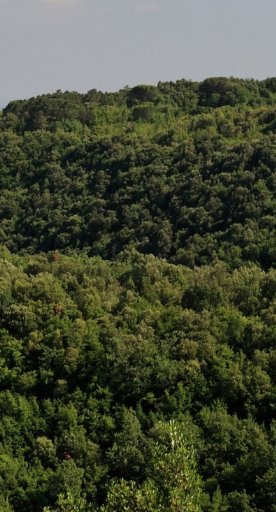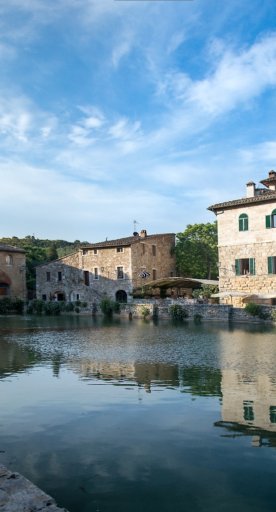
San Quirico d'Orcia
A historic village in the heart of Valdorcia along the Via Francigena
At the very heart of Val d’Orcia, nestled in the swirling hills, is the incredibly historic village with probable Etruscan origins, immersed in olive groves, vineyards and oak woods.
San Quirico d'Orcia, with its medieval parish churches, is an absolute must-visit. Find yourself in this enchanting scenery, famous for its beautiful countryside and harmonious atmosphere.
What to see in San Quirico d'Orcia
Just outside the city walls is the unmissable Collegiate Church of Saints Quirico and Giulitta, a Romanesque building whose first records date back as far as the 8th century. The church has three portals, one of which – facing Siena - is a splendid example of Romanesque design and its decor is a rare example of Lombard style in Tuscany. The first doorway is particularly remarkable and is credited to Giovanni Pisano. Many intriguing works are found inside, under a beautiful trussed ceiling, including an altarpiece by Sano di Pietro, a painter of the 15th century Sienese school.
Next to the Collegiate Church is Palazzo Chigi, a beautiful palace that is today home to the town hall. Continuing along Via Dante Alighieri, you’ll come across the Piazza della Libertà, the heart of San Quirico. Once here it’s worth visiting the Church of San Francesco, also called the Church of the Madonna, which has various Gothic elements. Inside the church is a beautiful Virgin attributed to Andrea della Robbia.
The historic centre of the village is particularly picturesque with its attractive paved streets and beautiful stone fountains. A distinctive part of the village’s history and appearance is its position along the Via Francigena route. It is crossed by Leg 35 that arrives at San Quirico from Ponte d'Arbia and Leg 36 from San Quirico to Radicofani. The importance of this in the town’s history is proven by the Scala Hospital, where hospitality was offered to pilgrims travelling.
It’s also worth visiting the Horti Leonini, a typical Italian Renaissance garden that occupies a large area of public space, which comprises the ancient bastions of the town. Designed around 1540 by Diomede Leoni, the gardens have a beautiful statue of Cosimo III de' Medici in the centre.
Take a visit to the remains of the Torre del Cassero, a historic medieval tower over 39 metres tall, which was unfortunately destroyed during the Second World War.
Just outside the city walls is the unmissable Collegiate Church of Saints Quirico and Giulitta, a Romanesque building whose first records date back as far as the 8th century. The church has three portals, one of which – facing Siena - is a splendid example of Romanesque design and its decor is a rare example of Lombard style in Tuscany. The first doorway is particularly remarkable and is credited to Giovanni Pisano. Many intriguing works are found inside, under a beautiful trussed ceiling, including an altarpiece by Sano di Pietro, a painter of the 15th century Sienese school.
Next to the Collegiate Church is Palazzo Chigi, a beautiful palace that is today home to the town hall. Continuing along Via Dante Alighieri, you’ll come across the Piazza della Libertà, the heart of San Quirico. Once here it’s worth visiting the Church of San Francesco, also called the Church of the Madonna, which has various Gothic elements. Inside the church is a beautiful Virgin attributed to Andrea della Robbia.
The historic centre of the village is particularly picturesque with its attractive paved streets and beautiful stone fountains. A distinctive part of the village’s history and appearance is its position along the Via Francigena route. It is crossed by Leg 35 that arrives at San Quirico from Ponte d'Arbia and Leg 36 from San Quirico to Radicofani. The importance of this in the town’s history is proven by the Scala Hospital, where hospitality was offered to pilgrims travelling.
It’s also worth visiting the Horti Leonini, a typical Italian Renaissance garden that occupies a large area of public space, which comprises the ancient bastions of the town. Designed around 1540 by Diomede Leoni, the gardens have a beautiful statue of Cosimo III de' Medici in the centre.
Take a visit to the remains of the Torre del Cassero, a historic medieval tower over 39 metres tall, which was unfortunately destroyed during the Second World War.
Nearby
The considerable richness of artistic, architectural and natural assets make San Quirico d'Orcia a particularly desirable destination even in Tuscany. Together with another five areas, San Quirico constitutes a considerable part of the Val d’Orcia Natural, Artistic and Cultural Park.
The picturesque hamlet of Bagno Vignoni also deserves a mention; its centre has developed around a large pool from which thermal waters flow. Bagno Vignoni’s waters were known in Etruscan times for their therapeutic and health benefits.
To the east of San Quirico d' Orcia, along the panoramic road that leads to Pienza, is one of the most beautiful and by far the most photographed spots in the entire Val d'Orcia: the Chapel of the Madonna di Vitaleta, a small chapel on top of a lovely hill and surrounded by a postcard landscape.
The considerable richness of artistic, architectural and natural assets make San Quirico d'Orcia a particularly desirable destination even in Tuscany. Together with another five areas, San Quirico constitutes a considerable part of the Val d’Orcia Natural, Artistic and Cultural Park.
The picturesque hamlet of Bagno Vignoni also deserves a mention; its centre has developed around a large pool from which thermal waters flow. Bagno Vignoni’s waters were known in Etruscan times for their therapeutic and health benefits.
To the east of San Quirico d' Orcia, along the panoramic road that leads to Pienza, is one of the most beautiful and by far the most photographed spots in the entire Val d'Orcia: the Chapel of the Madonna di Vitaleta, a small chapel on top of a lovely hill and surrounded by a postcard landscape.
Events
The Olive Oil Festival takes place every December 8, in San Quirico d’Orcia’s historic centre. Fire pits are set up and spaces for sampling fine food where bruschetta is made to offer to visitors. The village’s streets are brought to life with bands, stilt walkers and acrobats, while the restaurants will allow you to taste the traditional foods of Tuscan cuisine, all dressed with San Quirico oil, of course.
Don’t miss Forme nel Verde, an international contemporary sculpture exhibition hosted every year, from July to October, in the Horti Leonini. Mario Guidotti is behind the brilliant idea, founding it in 1971 and thus making art more alive and bringing it closer to the people and everyday life.
The Olive Oil Festival takes place every December 8, in San Quirico d’Orcia’s historic centre. Fire pits are set up and spaces for sampling fine food where bruschetta is made to offer to visitors. The village’s streets are brought to life with bands, stilt walkers and acrobats, while the restaurants will allow you to taste the traditional foods of Tuscan cuisine, all dressed with San Quirico oil, of course.
Don’t miss Forme nel Verde, an international contemporary sculpture exhibition hosted every year, from July to October, in the Horti Leonini. Mario Guidotti is behind the brilliant idea, founding it in 1971 and thus making art more alive and bringing it closer to the people and everyday life.
Typical products
San Quirico is crossed by the Orcia Wine Trail that winds in this territory characterized by a gorgeous hilly landscape, with an abundance of clay in the gullies and “biancane”, cereal crops and olive production. There is also, of course, the presence of vineyards. You absolutely must try the area’s typical products, including DOC Orcia Wine, Extra Virgin Olive Oil, pecorino cheese and the famous Cinta Senese.
San Quirico is crossed by the Orcia Wine Trail that winds in this territory characterized by a gorgeous hilly landscape, with an abundance of clay in the gullies and “biancane”, cereal crops and olive production. There is also, of course, the presence of vineyards. You absolutely must try the area’s typical products, including DOC Orcia Wine, Extra Virgin Olive Oil, pecorino cheese and the famous Cinta Senese.
What’s nearby?
Val d’Orcia

